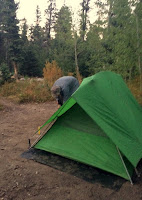Rocky Mountains looking eastward from Independence Pass
Part 2, Denver to Snowmass Colorado
We left Denver on a fine, late-summer day heading to Snowmass. Instead of the Interstate highway, we opted for "The Top of the Rockies National Scenic and Historic Byway." The byway winds through an area whose recent history is written in its place names - Cooper Mountain, Leadville, Gold Dust Mountain - names that attest to the area's mining boom in the late 1800s. The land was traditionally the hunting grounds of the Ute Indian tribe and before them to hunter gatherers stretching back to prehistoric times.
 One hundred and fifteen miles long from end to end, the byway leads up and over the Rocky Mountains through Independence Pass and then down into Aspen Colorado. Although well paved, the road's hairpin turns and precipitous drop-offs make for slow going, but slowing down and getting off the beaten path is the essence of the Great American Road Trip. As we climbed, clouds rolled in and the temperature dropped, but we were spared the summer storms and snow that can fall on any day of the year.
One hundred and fifteen miles long from end to end, the byway leads up and over the Rocky Mountains through Independence Pass and then down into Aspen Colorado. Although well paved, the road's hairpin turns and precipitous drop-offs make for slow going, but slowing down and getting off the beaten path is the essence of the Great American Road Trip. As we climbed, clouds rolled in and the temperature dropped, but we were spared the summer storms and snow that can fall on any day of the year.
The byway is the highest paved state highway in Colorado, reaching its apex of 12,096 feet at Independence Pass and the Continental Divide. We stopped and hiked out beyond the crowded viewing site. From our wind-swept, treeless, westward-facing vantage point, we could see the line of mountains where the waters of the continent part ways.
In the natural course of events, all the rivers and lakes to the east of the Rocky Mountains flow to the Gulf of Mexico and the Atlantic Ocean; all those to the west flow to the Gulf of California and the Pacific Ocean. In the West, as in many parts of the world where water has become the new gold, nature has very little say over rivers. In Colorado, 80 percent of the precipitation falls on the western side of the Rockies, but 80 percent of the population lives on the eastern side. Huge tunnels, dug through the mountains, divert the river waters from one side and move it to the other.
Just a few miles from Independence Pass are the headwaters of the Roaring Fork River. According to the Colorado Water Trust, "at times, more than 90 percent of the native flow of the Roaring Fork is diverted from the river for trans-mountain delivery to the Front Range." The mighty Colorado River, which provides water to 40 million people in seven western states, is dammed and diverted in so many places that today only one percent of its water actually reaches the sea.
None of this diminished state is obvious to us as we drive down the mountain toward Aspen, crossing and recrossing the Roaring Fork. It is a beautiful, fast-flowing stream, known for its great trout fishing, and farther downstream for its white water rafting. As we descend, the wind-swept, treeless summit gives way to confer forests and then to the delicate quaking aspen trees that give the town its name.
Like many towns in the region, Aspen got its start as a mining town. By 1891, the town had railway and tram lines, electrical power throughout the city, and a municipal water system. Fancy hotels, restaurants, and an opera house lined its downtown. Aspen was flooding the market with silver, producing one-sixteenth of all the silver mined in the world. Under pressure from influential mine owners to keep prices high, the US Government enacted the Sherman Silver Purchase Act. During its three years of existence, the Act required the US Treasury to make a monthly purchase at market price of 4,500,000 ounces of silver.
Other towns were not so lucky. On our way down the mountain, we passed Independence, the first thriving community in the Roaring Fork Valley. Today it's a ghost town, maintained by the Aspen Historical Society.
As we drove through Aspen on this late August, day, the town was uncrowded and lovely - a bit like a college town when the students are not there. We drove on, headed for nearby Snowmass, where we are lucky enough to have family. No roughing it for us - our nights for the next week would be spent in a lovely, soft bed with spectacular views of the mountains just out the window. Hiking, biking and lots of good food and good times were on the menu.
To read more about the Aspen/Snowmass area and to see photos, check out this Travel Oyster Blog, Colorado Outdoors.
Next we'll be heading across Utah and on to Great Basin National Park in Nevada where the real outdoor adventure begins.
Geraldine
Our route - starting in black and returning in yellow. 6,500 miles (10,500 km)










